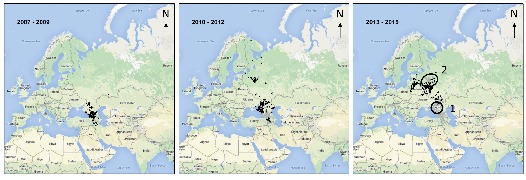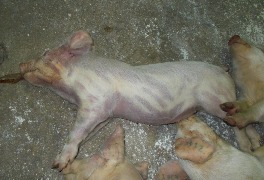African swine fever in the Russian Federation: who infects whom?
A new research contribution from the VEEPH group has recently been published on the transmission of African swine fever.
African swine fever (ASF) is a contagious viral disease of swine associated with very high lethality rates. It poses one of the biggest threats for the European pig industry because of its strong impact on pig production, pig health and the livelihood of farmers. In addition, there is neither treatment nor vaccine available to prevent its spread.
After its introduction into Georgia in 2007, the virus crossed the Caucasus and subsequently spread in the whole Western part of the Russian Federation (RF). Since 2014, several outbreaks in wild boar and domestic pig populations have been reported within the European Union (Estonia, Latvia, Lithuania and Poland).
To contribute to the understanding of the way the virus transmits, scientists from the Royal Veterinary College (RVC) and the National Research Institute for Veterinary Virology and Microbiology of Russia (VNIIVViM) collaborated to analyse the spatio-temporal distribution of ASF cases that were reported in two of the most affected regions of the RF between 2007 and 2014.

Figure 1: Dynamics of the ASF epidemic in Eastern Europe since its introduction in 2007.
Analyses showed that in both regions, outbreaks in domestic pigs that were close in space were more likely to also be close in time. This spatio-temporal interaction suggests a substantial role of the local farm-to-farm transmission through direct contacts between pigs from neighbouring farms, movement of contaminated vehicles, of people or the introduction of an infected animal from a neighbouring farm.
In addition, in one region, the location of outbreaks in domestic pigs and wild boar cases were correlated suggesting a sustained transmission from one species to the other. However, because outbreaks in domestic pigs were not statistically significantly clustered around wild boar cases, scientists argued that transmission from infected wild boar to susceptible domestic pig farms probably only played a marginal role in the epidemic. Consequently, the correlation of the spatial distributions of wild boar cases and outbreaks in domestic pigs could be explained by regular spill-overs from domestic pigs to the wild boar. In the other region, outbreaks in domestic pigs and wild boar cases were shown to have occurred independently from each other.
Results from this study stress the importance of local transmission between farms confirming the need to maintain high biosecurity standards on farms and justifying strict control measures targeted at domestic pigs such as culling of infected herds and local movement restrictions.

Picture 1: A pig dead of ASF in a Russian Farm, 2013 (Photo Credit: T. Vergne)
Citation:
Vergne, T; Gogin, A; Pfeiffer, DU. (2015)
Statistical Exploration of Local Transmission Routes for African Swine Fever in Pigs in the Russian Federation, 2007–2014.
Transboundary and Emerging Diseases
http://dx.doi.org/10.1111/tbed.12391
You may also be interested in:
-
New RVC study reveals 2075 percent rise in surgeries for French Bulldogs
New research from the Royal Veterinary College (RVC) has revealed a 2075% increase in soft-tissue …

